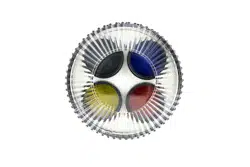
Lunar and Planetary
Filter Set, 1.25”
#94119-10
Eyepiece filters are an invaluable aid in
lunar and planetary observing. They reduce
glare and light scattering, increase contrast
through selective filtration, increase
definition and resolution, reduce irradiation,
and lessen eye fatigue.
Celestron’s filters are made of high quality,
solid plane parallel glass with excellent
homogeneity. The colored filters are
anti-reflection coated to prevent glaring
and ghosting. All eyepiece filters are
threaded to fit Celestron’s, and most other
manufacturer’s, 1¼” eyepieces, and offer
a full 26mm clear aperture.
Celestron filters are mounted in black
anodized aluminum cells with the Kodak
Wratten Series Number individually
labeled, and each set comes with a
plastic case for safe storage. The cells
of each filter are double-threaded so
they can be stacked (piggybacked) in
various combinations. This allows you to
create different color combinations and
transmission characteristics or to have
the same color characteristic, but with a
lower transmission. When stacking color
filters, the effective transmission of the
combination you create is equal to the
product of the spectral transmission of
each of the filters used. We recommend
stacking filters only if your telescope has at
least 8” of aperture.
#12 DEEP YELLOW,
74% LIGHT TRANSMISSION
Saturn– Penetrates and darkens atmospheric
currents containing low-hue blue tones.
Enhances orange and red features of
the belts and zones. Venus– Reveals
low-contrast surface features. Jupiter–
Penetrates and darkens atmospheric
currents containing low-hue blue tones.
Enhances orange and red features
of the belts and zones. Useful for
studies of the polar regions. Mars–
Reduces light from the blue and green
areas that darken the maria and
canal markings while lightening the
orange-hued desert regions. Also
sharpens the boundaries of yellow
dust clouds. Neptune– Improves detail
in larger telescopes (11” and larger
apertures). Uranus– Improves detail
in larger telescopes (11” and larger
apertures). Moon– Enhances lunar
features. Comets– Enhances definition
in comet tails.
#21 ORANGE,
46% LIGHT TRANSMISSION
Mars– Reduces light from the blue
and green areas that darken the maria
and canal markings while lightening the
orange-hued desert regions. Also sharpens
the boundaries of yellow dust clouds.
Mercury– Reduces the brightness of blue
sky during daylight observing to reveal
surface features. Saturn– Improves structure
of the Saturnian bands and highlights blue
polar regions. Venus– Use during daylight
observing to reduce brightness of blue
sky. Jupiter– Improves appearance and
detail revealed in structure of Jovian belts.
Enhances viewing of festoons and polar
regions. Moon– Greatly enhances lunar
features. Comets– Enhances definition
of comet dust tails and heads in larger
telescopes (11” and greater aperture).
Solar– When using some Mylar solar
filters, adding this orange filter restores
true color rendition.
#80A LIGHT BLUE,
30% LIGHT TRANSMISSION
Jupiter– Enhances the boundaries between
the reddish belts and adjacent bright zones.
Useful for viewing the Great Red Spot.
Mars– Very useful during the violet clearing.
Helpful in studying surface features and
polar caps. Mercury– Improves observation
of dusky surface markings at twilight,
when the planet is near the horizon.
Saturn– Enhances low-contrast features
between the belts and zones. Venus– Provides
increased contrast of dark shadings in upper
Venusian clouds. Moon– Enhances lunar
detail. Comets– Brings out the best definition
in comet gas tails.
#96ND-0.3 NEUTRAL DENSITY,
50% LIGHT TRANSMISSION
Moon– Excellent for reducing irradiation,
glare, and brightness. Colors are unaltered
as light is transmitted uniformly over
the entire spectrum. Planets– Stacking
in combination with color filters lowers
transmission but retains true color
balance for specific applications. Reduces
glare on brighter planets and minimizes
irradiation. Binary Stars– Aids in splitting
binary stars by reducing glare and
diffraction effects around the brighter star
of the binary pair.
CARE AND CLEANING OF THE
FILTERS
Avoid touching the optical surfaces of the
filters. Handle each filter by its cell only.
Keep the filters stored in the plastic case
when not in use.
Dust should normally be removed with a
blower bulb or an optical cleaning brush.
If a filter must be cleaned, use optical
grade tissue with a few drops of optical
cleaning solution applied to the tissue.
Gently wipe one small area at a time. Do
not rub. Use a new tissue and solution for
each wipe.
CELESTRON TWO YEAR
LIMITED WARRANTY
Celestron warrants your telescope mount
to be free from defects in materials and
workmanship for two years. Celestron
will repair or replace such product or
part thereof which, upon inspection by
Celestron, is found to be defective in
materials or workmanship. As a condition
to the obligation of Celestron to repair
or replace such product, the product
must be returned to Celestron together
with proof-of-purchase satisfactory
to Celestron.
Products or instructions may change without notice
or obligation. Designed and intended for those 14
years of age or older.
04-19
© 2019 Celestron • All rights reserved.
celestron.com/pages/technical-support
Telephone: 1(800)421-9649
2835 Columbia Street • Torrance, CA 90503 USA

